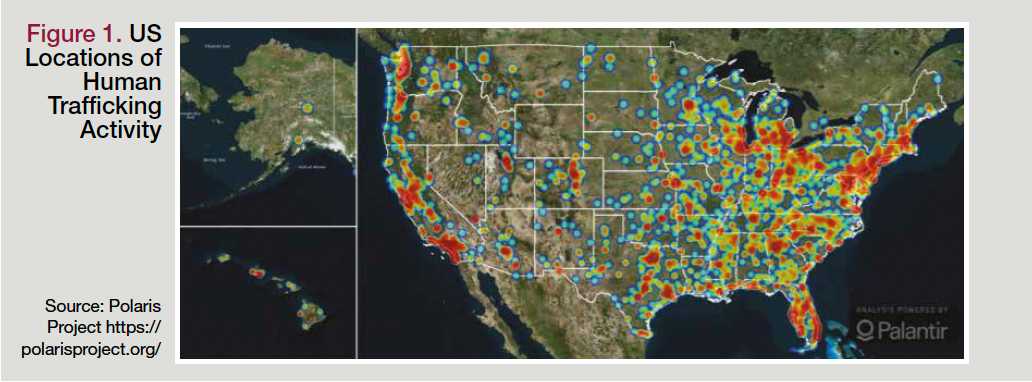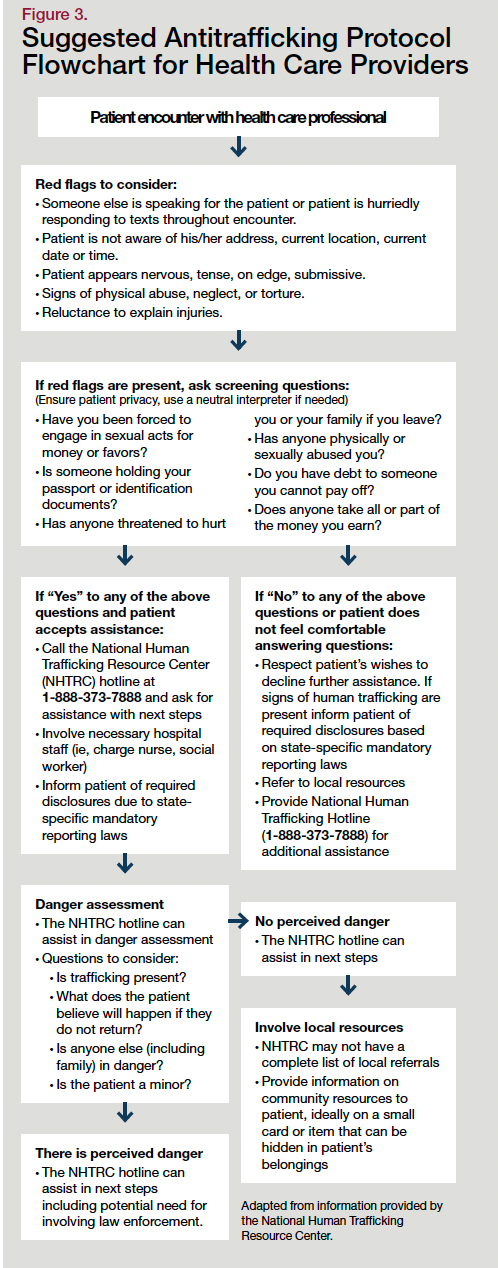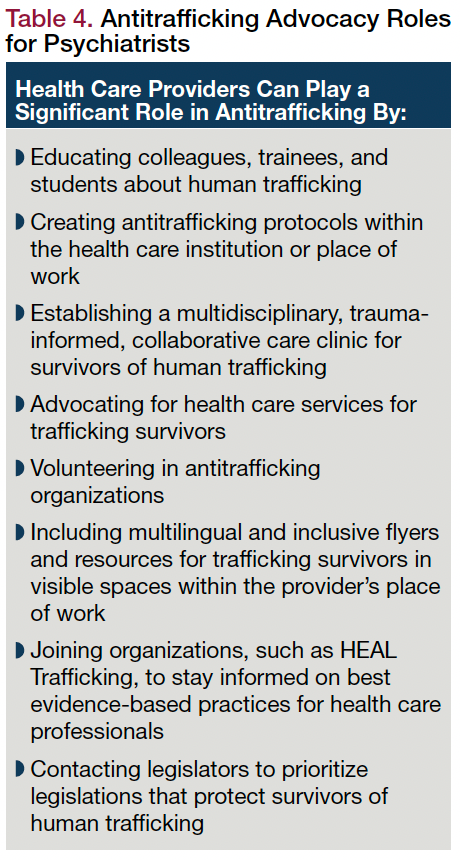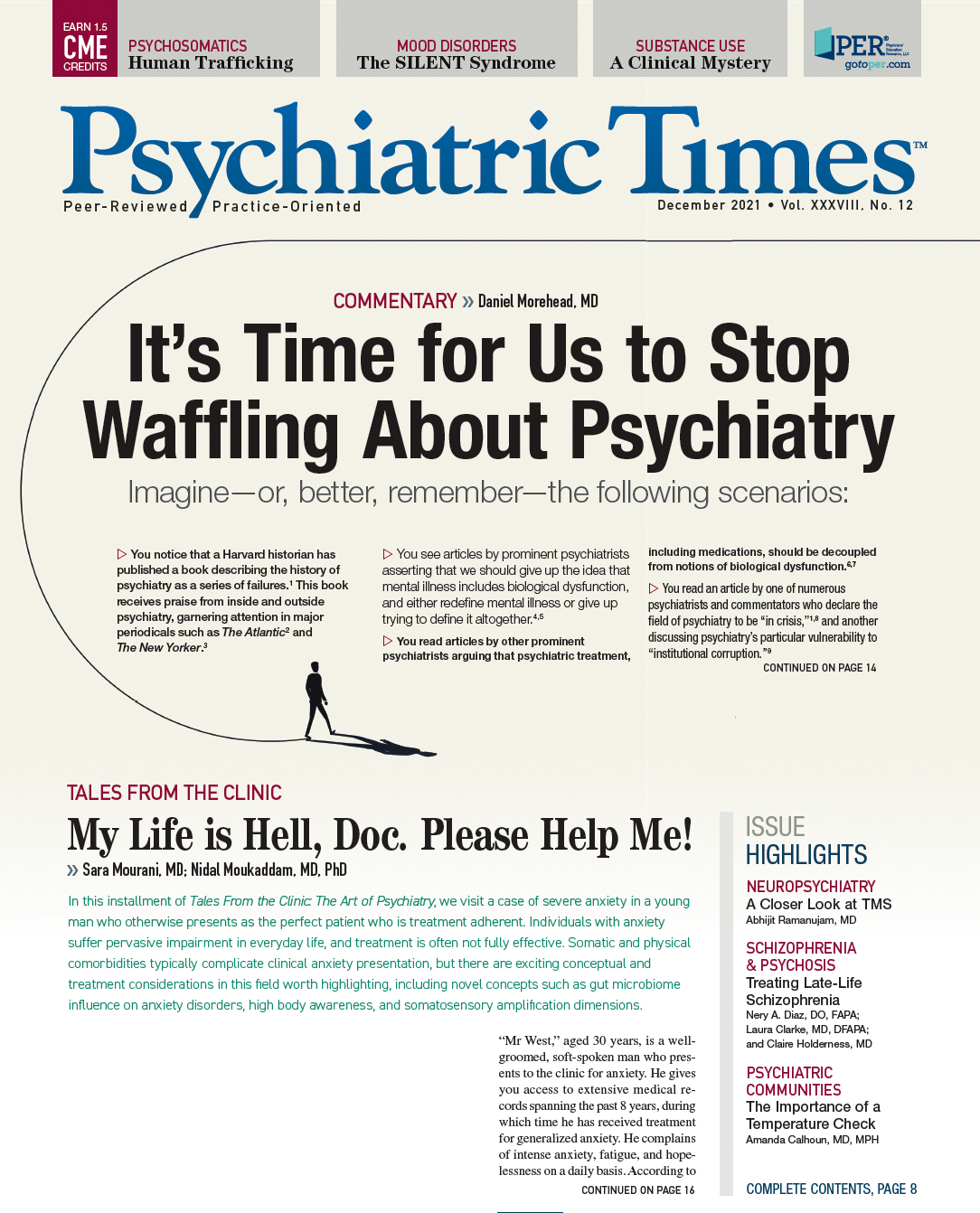CME
Article
Psychiatric Times
Psychiatrists’ Response to Human Trafficking
Author(s):
In this CME, learn to recognize risk factors and potential identifiers of human trafficking and identify trauma-informed approaches in evaluating human trafficking victims and survivors.
CATEGORY 1 CME
Premiere Date: December 20, 2021
Expiration Date: June 20, 2023
ACTIVITY GOAL
The goal of this activity is to provide psychiatrists with information to better understand, recognize, and address sequelae related to human trafficking.
LEARNING OBJECTIVES
After engaging with the content of this CE activity, you should be better prepared to:
1. Recognize risk factors and potential identifiers of human trafficking, including medical and psychiatric sequalae.
2. Identify trauma-informed approaches in evaluating human trafficking victims and survivors.
TARGET AUDIENCE
This accredited continuing education (CE) activity is intended for psychiatrists, psychologists, primary care physicians, physician assistants, nurse practitioners, and other health care professionals who seek to improve their care for patients with mental health disorders.
ACCREDITATION/CREDIT DESIGNATION/FINANCIAL SUPPORT
This activity has been planned and implemented in accordance with the accreditation requirements and policies of the Accreditation Council for Continuing Medical Education (ACCME) through the joint providership of Physicians’ Education Resource®, LLC, and Psychiatric TimesTM. Physicians’ Education Resource®, LLC, is accredited by the ACCME to provide continuing medical education for physicians.
Physicians’ Education Resource®, LLC, designates this enduring material for a maximum of 1.5 AMA PRA Category 1 Credits™. Physicians should claim only the credit commensurate with the extent of their participation in the activity.
This activity is funded entirely by Physicians’ Education Resource®, LLC. No commercial support was received.
OFF-LABEL DISCLOSURE/DISCLAIMER
This accredited CE activity may or may not discuss investigational, unapproved, or off-label use of drugs. Participants are advised to consult prescribing information for any products discussed. The information provided in this accredited CE activity is for continuing medical education purposes only and is not meant to substitute for the independent clinical judgment of a physician relative to diagnostic or treatment options for a specific patient’s medical condition. The opinions expressed in the content are solely those of the individual faculty members and do not reflect those of Physicians’ Education Resource®, LLC.
FACULTY, STAFF, AND PLANNERS’ DISCLOSURES AND CONFLICT OF INTEREST (COI) MITIGATION
The authors, peer reviewer, and the staff members of Physicians’ Education Resource®, LLC, and Psychiatric Times™ have no relevant financial relationships with commercial interests.
None of the staff of Physicians’ Education Resource®, LLC, or Psychiatric TimesTM, or the planners or the authors of this educational activity, have relevant financial relationship(s) to disclose with ineligible companies whose primary business is producing, marketing, selling, reselling, or distributing health care products used by or on patients.
For content-related questions, email us at PTEditor@mmhgroup.com. For questions concerning the accreditation of this CE activity or how to claim credit, please contact info@gotoper.com and include “Psychiatrists’ Response to Human Trafficking” in the subject line.
HOW TO CLAIM CREDIT
Once you have read the article, please use the following URL to evaluate and request credit: https://education.gotoper.com/activity/ptcme21dec. If you do not already have an account with PER® you will be prompted to create one. You must have an account to evaluate and request credit for this activity.
Human trafficking is a public health issue that involves exploiting individuals for forced sex or labor. Traffickers perpetuate the cycle of exploitation by utilizing methods such as emotional, economic, or physical abuse; isolation; and threats. Physical, mental, legal, and social sequelae of human trafficking can persist for years after individuals survive their trafficking situations. Individuals with a preexisting history of psychiatric illnesses, including substance use disorders, are especially vulnerable to being trafficked.
Figure 1. US Locations of Human Trafficking Activity

Human trafficking is a problem worldwide, including in the United States (Figure 1).1,2 The practice is not limited to cities; it is also prevalent in suburbs and rural towns. There are misconceptions that victims are only foreign-born individuals, members of minority groups, and/or people who come from low socioeconomic backgrounds. The truth, however, is that victims can be of any race, gender, nationality, socioeconomic group, or background. In addition to sex trafficking, human trafficking also consists of forced labor across both legitimate and illegitimate businesses, including sweatshops, massage parlors, agriculture, domestic service (eg, cleaning, childcare, elder care), and travel and service industries (Figure 2).
Figure 2. A Closer Look at Types of Human Trafficking

Survivors experience many barriers in accessing health care services; among them are a sense of fear, distrust, shame, guilt, isolation, and worries about criminal charges. However, other barriers can be modified by educating and promoting changes in the actions of health care professionals.3
Mental and Physical Health Sequelae
Human trafficking is associated with an increased risk of psychiatric disorders and medical complications. The most commonly reported psychiatric problems include depressive disorders, anxiety disorders, posttraumatic stress disorder, insomnia, and eating disorders. As a result, human trafficking survivors have an increased risk of involuntary admission to inpatient psychiatry units and are more likely to have longer inpatient psychiatric stays.4-7
Due to poor working and living conditions as well as exposure to violence, individuals who experience trafficking are at increased risk of physical injuries, including fractures, head trauma, and stab wounds. Higher rates of unintended pregnancies, chronic pain, poor nutrition, and sexually transmitted infections, including HIV, are some of the many medical consequences of human trafficking.4,7-9
Assessment
Studies have shown that up to 88% of human trafficking victims had contact with a health care provider while actively being trafficked, which means opportunities were missed to help the victim.4,5 This is especially true in emergency departments, family medicine clinics, and obstetrics and gynecology settings.4 Among the cited barriers to the proper identification and care of human trafficking victims and survivors are the lack of hospital screening protocols for human trafficking; a high volume of patients seen by clinicians with time constraints that keep patient interactions short; and the burden of documentation. In addition, physicians, including psychiatrists, seldom receive the necessary education on human trafficking that would help reduce missed opportunities for identifying victims.10,11
Table 1. Red Flags That May Indicate Human Trafficking12,13

Psychiatrists are leaders in trauma-informed care and experts in the assessment and management of psychiatric disorders. Thus, psychiatrists stand in a unique position to bridge victims and individualized multidisciplinary resources, as well as to provide education on human trafficking to other clinicians, health care providers, trainees, and students. As a result, it is imperative that psychiatrists learn to screen for and identify potential human trafficking victims within the health care system in order to better address victims’ and survivors’ physical and mental health needs.
Figure 3. Suggested Antitrafficking Protocol Flowchart for Health Care Providers

The goal of screening for human trafficking should not be for the purpose of disclosure—as it can retraumatize a patient who may not be ready to disclose—but rather to assess the need for and inform the patient of available resources.12 Table 1 lists potential physical, behavioral, and environmental red flags to look for during an encounter that may alert a psychiatrist to a potential human trafficking victim.12,13
Table 2. Six Principles That Guide a Trauma-Informed Approach16

The National Human Trafficking Resource Center provides a suggested protocol flowchart for use in a hospital-wide setting, which includes several questions that can be used in the assessment of human trafficking (Figure 3).14 Further research is needed to develop and validate brief, effective tools for physicians that will help in identifying children, youth, and adults who are being trafficked for sex and/or labor or who are at risk of such exploitation.15
Table 3. The PEARR Tool17

Beyond screening tools, a patient who is trafficked or is at risk of being trafficked should feel comfortable sharing their concerns and experiences with physicians. It is thus recommended that physicians utilize the 6 principles of trauma-informed care when evaluating any patient with suspected trafficking experience (Table 2).16 A physician utilizing these principles is able to understand the impact of trauma, recognize the signs and symptoms of traumatic stress, and respond to the patient in a nonjudgmental and respectful manner in order to empower the patient without retraumatization. The PEARR tool (Table 3) can help physicians assess and assist human trafficking victims via a trauma-informed approach.17
Case Vignette
“Ms Zankowski,” aged 28 years, is a female patient with a history of migraine headaches and hepatitis C who presented to her primary care physician for her annual physical evaluation. She disclosed a prior diagnosis of posttraumatic stress disorder relating to physical and sexual abuse during childhood, followed by a history of experienced violence as an adult. She also reported a history of alcohol use disorder and cannabis use disorder.
Ms Zankowski reported fleeing her family home at age 18 years to escape the family abuse. An older man found her on the street and promised her protection, housing, and food. After earning her trust, he began to pimp her, threatening to kill her if she told anyone. Ms Zankowski spent the next 10 years being forced to sell her body on the streets under the control of a series of traffickers. She coped with this trauma by drinking alcohol and smoking cannabis.
Ms Zankowski had 1 prior psychiatric hospitalization for a suicide attempt and was discharged on sertraline 100 mg daily. She was unable to adhere to sertraline on an outpatient basis due to her inability to access her identification cards or health care services while under the control of her trafficker.
After some time, Ms Zankowski was able to escape her trafficker and reside safely in a women’s shelter. After being assigned a case manager at the shelter, Ms Zankowski was able to get connected to health care resources including a visit to a primary care physician. By establishing a nonjudgmental, collaborative, and therapeutic doctor-patient relationship, Ms Zankowski was slowly able to trust her primary care physician enough for her to open up about her posttraumatic stress disorder and prior trauma history. Her primary care physician connected her with preventive care services and referred her to an integrated psychiatry care clinic for survivors of human trafficking. This specialty clinic provided psychiatry, psychology, social work, and case management services.
Table 4. Antitrafficking Advocacy Roles for Psychiatrists

Ms. Zankowski subsequently was restarted on sertraline and began individual psychotherapy. She started to attend Alcoholics Anonymous meetings and participated in an ongoing relapse prevention plan. She enrolled in vocational services and planned to complete a General Educational Development program. As a result of the trauma-informed care provided, she benefited from peer support services within a safe, trustworthy, and multidisciplinary clinical environment. As she moved forward, Ms Zankowski felt empowered to make choices for herself and to use her voice to express her feelings.
Future Directions
Multidisciplinary teams and integrated psychiatry care are crucial to meeting human trafficking survivors’ health care and psychosocial needs (Table 4). By understanding human trafficking, educating health care providers about trauma and trauma-informed care, developing screening tools, expanding access to care, and promoting partnerships with health care professionals across different disciplines and the community, integrated care models can support survivors and build a stronger response to end human trafficking. Amplifying survivors’ voices and establishing equal partnerships with survivors of human trafficking is essential in enhancing antitrafficking education for health care providers.18
Dr Alhajji is an assistant professor in the Department of Psychiatry and Behavioral Sciences at the University of Miami Miller School of Medicine. Dr Hadjikyriakou is a Consultation-Liaison Psychiatry fellow at the University of Miami Miller School of Medicine. Dr Padilla is Consultation-Liaison Psychiatry Fellowship Program Director at the University of Miami Miller School of Medicine.
References
1. Human trafficking. US Department of Justice. Accessed October 29, 2021. https://www.justice.gov/humantrafficking
2. 2019 Data Report: The U.S. National Human Trafficking Hotline. Polaris Project. Accessed November 4, 2021. https://polarisproject.org/wp-content/uploads/2019/09/Polaris-2019-US-National-Human-Trafficking-Hotline-Data-Report.pdf
3. Armstrong S, Greenbaum VJ. Using survivors’ voices to guide the identification and care of trafficked persons by U.S. health care professionals: a systematic review. Adv Emerg Nurs J. 2019;41(3):244-260.
4. Lederer LJ, Wetzel CA. The health consequences of sex trafficking and their implications for identifying victims in healthcare facilities. Ann Health Law. 2014;23(1):61-91.
5. Shandro J, Chisolm-Straker M, Duber HC, et al. Human trafficking: a guide to identification and approach for the emergency physician. Ann Emerg Med. 2016;68(4):501-508.e1.
6. Altun S, Abas M, Zimmerman C, et al. Mental health and human trafficking: responding to survivors’ needs. BJPsych Int. 2017;14(1):21-23.
7. Ottisova L, Hemmings S, Howard LM, et al. Prevalence and risk of violence and the mental, physical and sexual health problems associated with human trafficking: an updated systematic review. Epidemiol Psychiatr Sci. 2016;25(4):317-341.
8. Le PTD, Ryan N, Rosenstock Y, Goldmann E. Health issues associated with commercial sexual exploitation and sex trafficking of children in the United States: a systematic review. Behav Med. 2018;44(3):219-233.
9. Muftic LR, Finn MA. Health outcomes among women trafficked for sex in the United States: a closer look. J Interpers Violence. 2013;28(9):1859-1885.
10. Barriers that prevent identification. National Human Trafficking Training and Technical Assistance Center. Accessed October 28, 2021. https://nhttac.acf.hhs.gov/soar/eguide/observe/Barriers_to_Screening_and_Responding
11. Coverdale JH, Gordon MR, Nguyen PT, eds. Human Trafficking: A Treatment Guide for Mental Health Professionals. American Psychiatric Association Publishing; 2020.
12. Identifying victims of human trafficking: what to look for in a healthcare setting. National Human Trafficking Resource Center. Accessed October 28, 2021. https://humantraffickinghotline.org/sites/default/files/What%20to%20Look%20for%20during%20a%20Medical%20Exam%20-%20FINAL%20-%202-16-16.pdf
13. OBSERVE: identify individual and environmental indicators of trafficking. National Human Trafficking Training and Technical Assistance Center. Accessed October 28, 2021. https://nhttac.acf.hhs.gov/soar/eguide/observe
14. Framework for a human trafficking protocol in healthcare settings. National Human Trafficking Hotline. January 2010. Updated February 2016. Accessed October 28, 2021. https://humantraffickinghotline.org/resources/framework-human-trafficking-protocol-healthcare-settings
15. Different approaches to the conversation. National Human Trafficking Training and Technical Assistance Center. Accessed October 28, 2021. https://nhttac.acf.hhs.gov/soar/eguide/ask/different-approaches-to-the-conversation
16. Infographic: 6 guiding principles to a trauma-informed approach. CDC / Center for Preparedness and Response. Updated September 17, 2020. Accessed October 28, 2021. https://www.cdc.gov/cpr/infographics/6_principles_trauma_info.htm
17. Using the PEARR tool. Dignity Health. 2019. Accessed October 28, 2021. https://www.dignityhealth.org/hello-humankindness/human-trafficking/victim-centered-and-trauma-informed/using-the-pearr-tool
18. Panda P, Mango A, Garg A. Responsibly including survivors’ voices in the planning and implementing of educational programmes for healthcare providers. Anti-Trafficking Review. 2021;(17):148-153. ❒







